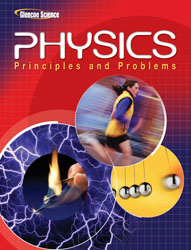1 4 N. What power does the motor produce in kilowatts?A) 10.9 kW B) 1.09×104 kW C) 2.45×104 kW D) 245 kW 2 In the figure below, if the force exerted on the backpack is 20.0 N and the distance it acts over is 0.25 m, what is the change in kinetic energy of the backpack?
<a onClick="window.open('/olcweb/cgi/pluginpop.cgi?it=jpg::::/sites/dl/free/0078807220/617918/lw.JPG','popWin', 'width=NaN,height=NaN,resizable,scrollbars');" href="#"><img valign="absmiddle" height="16" width="16" border="0" src="/olcweb/styles/shared/linkicons/image.gif"> (4.0K)</a> A) 2.5 J B) 5.0 J C) 4.0×101 J D) 8.0×101 J 3 A) is zero B) decreases C) increases D) remains constant 4 A) 5.00×102 J B) 51.0 J C) 125 J D) 98.0 J 5 A) calorie B) newton C) volt D) watt 6 A) 1.13×103 J B) 1.65×102 J C) 2.78×103 J D) 1.65×103 J 7 A) 8.6×105 J B) 9.6×103 J C) 8.6×104 J D) 3.1×105 J 8 In the figure below, if the force exerted on a 3.0-kg backpack that is initally at rest is 20.0 N and the distance it acts over is 0.25 m, what is the final speed of the backpack?
<a onClick="window.open('/olcweb/cgi/pluginpop.cgi?it=jpg::::/sites/dl/free/0078807220/617918/lw.JPG','popWin', 'width=NaN,height=NaN,resizable,scrollbars');" href="#"><img valign="absmiddle" height="16" width="16" border="0" src="/olcweb/styles/shared/linkicons/image.gif"> (4.0K)</a> A) 1.8 m/s B) 2.8 m/s C) 5.0 m/s D) 3.3 m/s 9 A) 40.3 J B) 71.2 J C) 4.11 J D) 262 J 10 A) W = Fd cos Δ B) W = F /m C) W = Fd D) W = F ΔKE 11 A) potential B) kinetic C) mechanical D) thermal 12 A) 9.10 J B) 127 J C) 0.26 J D) 66.4 J 13 A) 38.4 J B) 217 J C) 123 J D) 376 J 14 A) power B) the ability of an object to produce change in the environment or itself C) motion D) the effort required to perform work 15 A) 38.4 J B) 376 J C) 225 J D) 123 J 16 A) when a machine works at 100 percent efficiency, the energy of the system remains constant B) when work is done at a rate of one joule per second, the power produced is one watt C) when work is done on an object, a change in kinetic energy results. D) effort is required to resist a change in the energy of a system 17 A) 1 N·s B) 1 N·m/s C) 1 N·m D) 1 F r /F e 18 A) ampere B) volt C) joule D) watt 19 A) 1.6×102 N B) 1.6×103 N C) 4.9 N D) 6.3 N 20 A) 5.47×103 J B) 4.31×103 J C) 3.37×103 J D) 3.37×102 J 21 A) 1.96×103 J B) 1.59×103 J C) 1.96×102 J D) 2.78×103 J 22 A) initial 4.80×105 J, final 3.07×105 J B) initial 2.40×105 J, final 1.54×105 J C) initial 1.54×105 J, final 2.40×105 J D) initial 3.07×105 J, final 4.80×105 J 23 A) 3.6×103 kg B) 3.5×103 kg C) 7.2×102 kg D) 3.6×102 kg 24 A) W = Fd B) W = F ΔKE C) W = ma D) W = F /m 25 A) 1.96×106 J B) 2.03 J C) 1.96×103 J D) 2.03×103 J 26 3 m/s, a 35.0-kg cheetah running at 30 m/s, an 875-kg car traveling at 5 m/s, or a 148-g pitched baseball moving at 45 m/s?A) bullet B) cheetah C) car D) baseball 27 A) 9.10 J B) 12.8 J C) 25.5 J D) 47.6 J 28 3 -kg car a distance of 2.4 m. If the car is lifted in 47 s, how much power does the lift produce?A) 570 kW B) 290 W C) 570 W D) 58.2 W 29 A) Energy B) Force C) Power D) Effort 30 A) torque B) mechanical advantage C) power D) efficiency 31 If the machine below is ideal and an effort force of 7.0 N just lifts a 14.0 N box situated 0.75 m from the pivot, what is the distance from the pivot point to where the effort force is exerted?
<a onClick="window.open('/olcweb/cgi/pluginpop.cgi?it=jpg::::/sites/dl/free/0078807220/617918/lx.JPG','popWin', 'width=NaN,height=NaN,resizable,scrollbars');" href="#"><img valign="absmiddle" height="16" width="16" border="0" src="/olcweb/styles/shared/linkicons/image.gif"> (4.0K)</a> A) 2.0 m B) 0.38 m C) 1.5 m D) 65 m 32 If the efficiency of the pulley system bellow is 95 percent, what effort force must be exerted to lift a 20.0 N box at constant velocity?
<a onClick="window.open('/olcweb/cgi/pluginpop.cgi?it=jpg::::/sites/dl/free/0078807220/617918/ly.JPG','popWin', 'width=NaN,height=NaN,resizable,scrollbars');" href="#"><img valign="absmiddle" height="16" width="16" border="0" src="/olcweb/styles/shared/linkicons/image.gif"> (4.0K)</a> A) 20 N B) 19 N C) 22 N D) 21 N 33 A) IMA B) mechanical advantage C) efficiency D) reliability 34 A) 1.45×102 cm B) 1.45 cm C) 2.12 cm D) 2.21 cm 35 A) mechanical advantage B) effort force C) mechanical force D) resistance force














